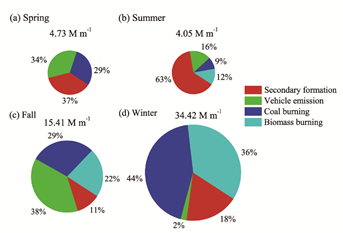Yuan, W., Huang, R. J.*, Yang, L., Guo, J., Chen, Z., Duan, J., Wang, T., Ni, H., Han, Y., Li, Y. J., Chen, Q., Chen, Y., Hoffmann, T., and O'Dowd, C.: Characterization of the light absorbing properties, chromophores composition and sources of brown carbon aerosol in Xi'an, Northwest China, Atmos. Chem. Phys., 20, 5129-5144, 2020.
Particulate matter (PM) pollution is a severe environmental problem in Xi’an, Northwest China. Brown carbon (BrC) is an important component of atmospheric aerosol particles, which can efficiently absorb solar radiation and has significant effects on radiative forcing and climate. The chromophores composition and sources of BrC are still relatively less known.
A research group led by Prof. HUANG Rujin from the Institute of Earth Environment of the Chinese Academy of Sciences (IEECAS), used the UV–Vis spectrophotometer
(300–700 nm) equipped with a liquid waveguide capillary cell (LWCC-3100), gas chromatograph–mass spectrometer (GC–MS) and PMF/ME-2 to investigate the light
absorption properties, chromophore composition and sources of BrC.
The light absorption coefficient of water-soluble and methanol-soluble BrC, and concentrations of WSOC and OC show similar seasonal variations, with the highest average in winter, followed by fall, spring and summer.
The contributions of 12 PAHs, 10 NACs and 3 MOPs to the light absorption of methanol-soluble BrC were determined and showed large seasonal variations. Specifically, the total contribution to methanol-soluble BrC light absorption at 365 nm ranged from 1.1%to 3.3 %, which is 5–7 times higher than their carbon mass fractions in total OC. This result indicates that the light absorption of BrC is likely determined by an amount of chromophores with strong light absorption ability.
Four major sources of methanol-soluble BrC were identified, including secondary formation, vehicle emission, coal combustion and biomass burning. On average, vehicular emissions and secondary formation are major sources of BrC (~70 %) in spring, coal combustion and vehicular emissions are major sources (~70 %) in fall, biomass burning and coal combustion become major sources (~80 %) in winter, and secondary BrC dominates (~60 %) in summer.
This study, published in Atmospheric Chemistry and Physics, highlighted the seasonal differences of light absorbing properties, chromophores composition and sources of BrC and indicated opportunities for air quality improvement by mitigating direct emissions.

Fig. 1 Time series of the light absorption coefficient of water-soluble and methanol-soluble BrC at 365 nm (Abs365,WSOC and Abs365,MSOC, respectively) as well as OC and WSOC concentrations.

Fig. 2 Contributions of the major sources to Abs365,MSOC in Xi’an during spring, summer, fall and winter.

